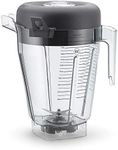Buying Guide for the Best Vitamix Blenders
Choosing the right blender, especially from a reputable brand like Vitamix, can make a big difference in your kitchen experience. The best blender for you depends on what you plan to use it for, how often you’ll use it, and your preferences for convenience and features. Understanding the key specifications will help you match a blender to your needs, ensuring you get the most value and satisfaction from your purchase.Motor PowerMotor power, usually measured in horsepower (HP) or watts, determines how effectively the blender can handle tough ingredients like ice, nuts, and fibrous vegetables. Higher power means smoother blends and the ability to tackle more challenging tasks. Blenders with lower power (around 1-1.5 HP or 1000-1200 watts) are suitable for basic smoothies and soft ingredients. Mid-range power (1.5-2 HP or 1200-1500 watts) can handle most home blending needs, including frozen fruits and some nut butters. High power (over 2 HP or 1500+ watts) is best for frequent use, large batches, or making things like hot soups and dough. If you plan to blend tough ingredients often or want the smoothest results, opt for higher power; for occasional or simple use, lower power may suffice.
Container SizeThe container size, measured in ounces or liters, affects how much you can blend at once. Smaller containers (32-48 ounces) are great for individuals or small families, and for making single servings or small batches. Larger containers (64 ounces or more) are ideal for bigger families, meal prep, or entertaining. If you usually make small smoothies or sauces, a smaller container is more convenient and easier to clean. If you often prepare large quantities or want to blend soups or batters, a larger container is more practical.
Control OptionsBlenders come with different control options, such as manual dials, preset programs, or simple switches. Manual controls give you more flexibility to adjust speed and blending time, which is useful if you like to experiment or want precise control. Preset programs automate common tasks like smoothies, soups, or frozen desserts, making blending easier and more consistent. If you prefer simplicity and convenience, look for models with presets; if you want more hands-on control, choose one with variable speed dials.
Blade DesignBlade design affects how efficiently the blender chops and blends ingredients. Some blades are designed for wet blending (liquids, smoothies), while others are optimized for dry blending (grains, nuts). Most users will be fine with standard wet blades, but if you plan to grind grains or make flours, look for a model with a dry blade option. The quality and shape of the blades also influence how smooth your blends will be, so consider your typical recipes when deciding.
Ease of CleaningEase of cleaning is important for everyday use. Some blenders have self-cleaning functions, where you just add water and a drop of soap and run the blender. Others have dishwasher-safe containers and lids. If you want to minimize cleanup time, look for these features. If you don’t mind hand-washing, this may be less important, but for frequent use, easy cleaning can make a big difference.
Noise LevelBlenders can be quite loud, especially high-powered ones. Some models are designed with noise-reducing features like insulated containers or sound enclosures. If you have a sensitive household, blend early in the morning, or just prefer a quieter kitchen, consider a model with noise reduction. If noise isn’t a concern, you can focus on other features.
Durability and WarrantyDurability is key for a long-lasting blender, and a good warranty is a sign of quality. Vitamix blenders are known for their robust build, but warranty lengths can vary. A longer warranty gives peace of mind, especially if you plan to use the blender heavily. If you expect to use your blender daily or for tough tasks, prioritize models with strong build quality and a comprehensive warranty.















